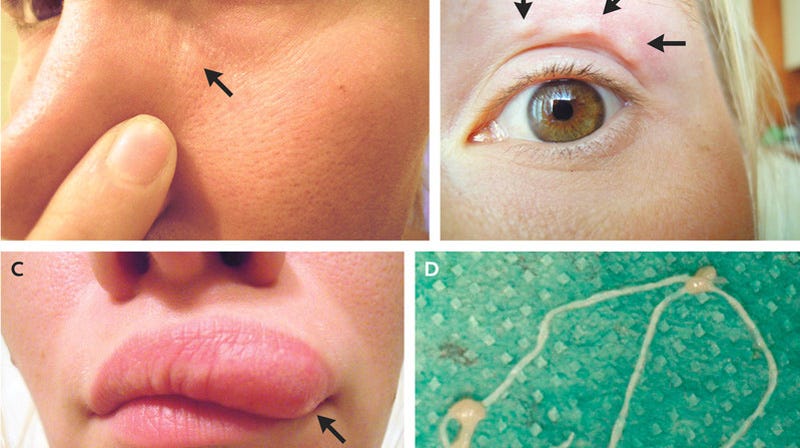 Worst vacation slideshow ever.Photo: Kartashev and Simon (New England Journal of Medicine)
Worst vacation slideshow ever.Photo: Kartashev and Simon (New England Journal of Medicine)
A woman’s selfies helped her monitor the movements of an unwelcome guest: a roving parasitic worm living in her face. Thankfully, doctors were able to get the pesky pest—which she likely caught overseas from a mosquito—out of her body without any problems.
The woman’s unsettling story was detailed in a case report published by her doctors this month in the New England Journal of Medicine. According to the report, the 32-year-old woman had decided to visit an ophthalmologist (an eye doctor) two weeks after she had started having itchy, burning skin bumps that moved around her face. At first, the bump was below her left eye. Five days later, it had moved to above the left eye, 10 days after after that, it was on her upper lip. The woman used the selfies (available in their full, horrifying detail here) to document her ordeal.
Upon examination, the woman’s doctor found a “moving oblong nodule” in her upper left eyelid, and used forceps to yank the long, thin sucker out surgically. Following DNA testing, they managed to identify the culprit, a parasitic roundworm known as Dirofilaria repens.
D. repens aren’t native to the US, but do frequent parts of Europe and Asia. And as it turned out, the woman had just returned from a trip to Russia, where she visited a rural area outside of Moscow. Tellingly, she also remembered being bitten by lots of mosquitos, who help spread the worm from victim to victim. D. repens doesn’t particularly like people as hosts, mostly sticking to dogs and other carnivores (one of its cousins is the heartworm that also plagues pooches). But sometimes people can become victims.
Unlike some other species of parasitic worm that might require antiparasitic medication to clear up, simply removing a wayward D. repens is often cure enough. Most human infestations only feature a single, infertile worm, unable to do much of anything but freak out the host’s immune system, which traps the worm in a “nodule” underneath the skin (in rare cases, however, the worm can cause more serious organ damage).
The woman in this case has since made a full recovery. I mean, aside from having the mortifying memory of a living noodle crawling inside you rent-free for at least two weeks. Still, it could have been worse: Some D. repens worms are known to live as long as 10 years.
[New England Journal of Medicine]